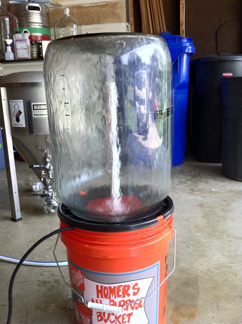
Cleaning carboys has to be the worst part of brewing. I despised the process so much that I would let dirty carboys sit for weeks before summoning enough motivation to get cleaning. I used the same process for seven years: soak the carboy overnight with water to loosen the crap stuck to the glass, scrub it with a brush, fill it with PBW and soak for 30 min, rinse with water. There was heavy lifting of slippery glass, awkwardly holding it while draining in the bathtub, the inevitability of getting water everywhere—cleaning sucks!
I finally got fed up with the process and looked online to see what others were doing. I quickly found people having success with pond pumps. A quick trip to the hardware store and a bit of tinkering resulted in a washer that works better than I could have imagined.
With this setup, I have completely removed all heavy and awkward lifting, reduced the cleaning time to 15 minutes and saved tons of money in PBW as I now only use one or two gallons of solution as opposed to six. Also, when washing kegs, I can now be certain the posts, valves, o-rings, tubes and fittings are getting adequately cleaned.
Construction
 The basic setup is a 1/2″ diameter vertical tube attached to a pond pump that sits in a five-gallon bucket and re-circulates cleaning solution through your carboy.
The basic setup is a 1/2″ diameter vertical tube attached to a pond pump that sits in a five-gallon bucket and re-circulates cleaning solution through your carboy.
The entire setup is approximately 26″ tall, and uses 3/4″ tubing everywhere except for the 16-inch long, 1/2″ diameter tube that projects the solution into the carboy.
Just above the pump I added an attachment that diverts cleaning solution to a pair of keg fittings. This addition ensures that when you are cleaning your kegs, every component of the keg gets cleaned, not just the interior walls.
Just above the keg cleaning attachment I included an 11″ wide cross section. The cross section has two purposes: first, it ensures the pump will be centered in the bucket, and second, it acts as a stand for an inverted keg to sit on while being washed.
The lid to the bucket is not necessary when cleaning kegs, however, when cleaning carboys, the lid acts as a stand for the carboy to sit stable over the pump. I find a 6″ diameter hole in the lid provides adequate stability for both five and six gallon carboys.
Building Tips
- The pump I use has a 3/4″ outlet. You may need to slightly widen the inner diameter of a piece a 3/4″ tubing to fit over the outlet. I used a large file to accomplish this.
- Build the bottom portion using 3/4″ tubing, but use 1/2″ tubing for reaching up into the carboy. You want to make sure there is enough room for water to drain out of the carboy.
- Don’t permanently attach the keg cleaning T to the rest of the set up. You may find the need to remove it when cleaning carboys.
Using the Keg and Carboy Washer
- Fill bucket one with warm PBW solution, and bucket two with warm water, enough to cover the pump.
- A 15-minute PBW wash. If washing a carboy, place the lid on the bucket, and the carboy on the lid. If washing a keg, attach the fittings to the keg and place the keg in the bucket.
- A 30-second water rinse. Move the entire pump setup from the PBW bucket to the water bucket.
Materials
- 600 gal/hour pond pump
- 3/4″ pipe (2 ft section cut to size)
- 1/2″ pipe (2 ft section cut to size)
- 3/4″ T fitting
- 3/4″ cross fitting
- 3/4″ slip to 1/2″ threaded elbow
- 3/4″ to 1/2″ reducer
- Two 3/4″ caps
- Male 1/2″ threaded to 3/8″ barb
- 3/8″ tubing cut to size
- 3/8″ barbed T fitting
- Two 3/8″ barbed swivel nuts
- Six worm clamps
- CO2 and liquid keg disconnects
- Two five-gallon buckets
- Lid with 6″ diameter hole


Share Post